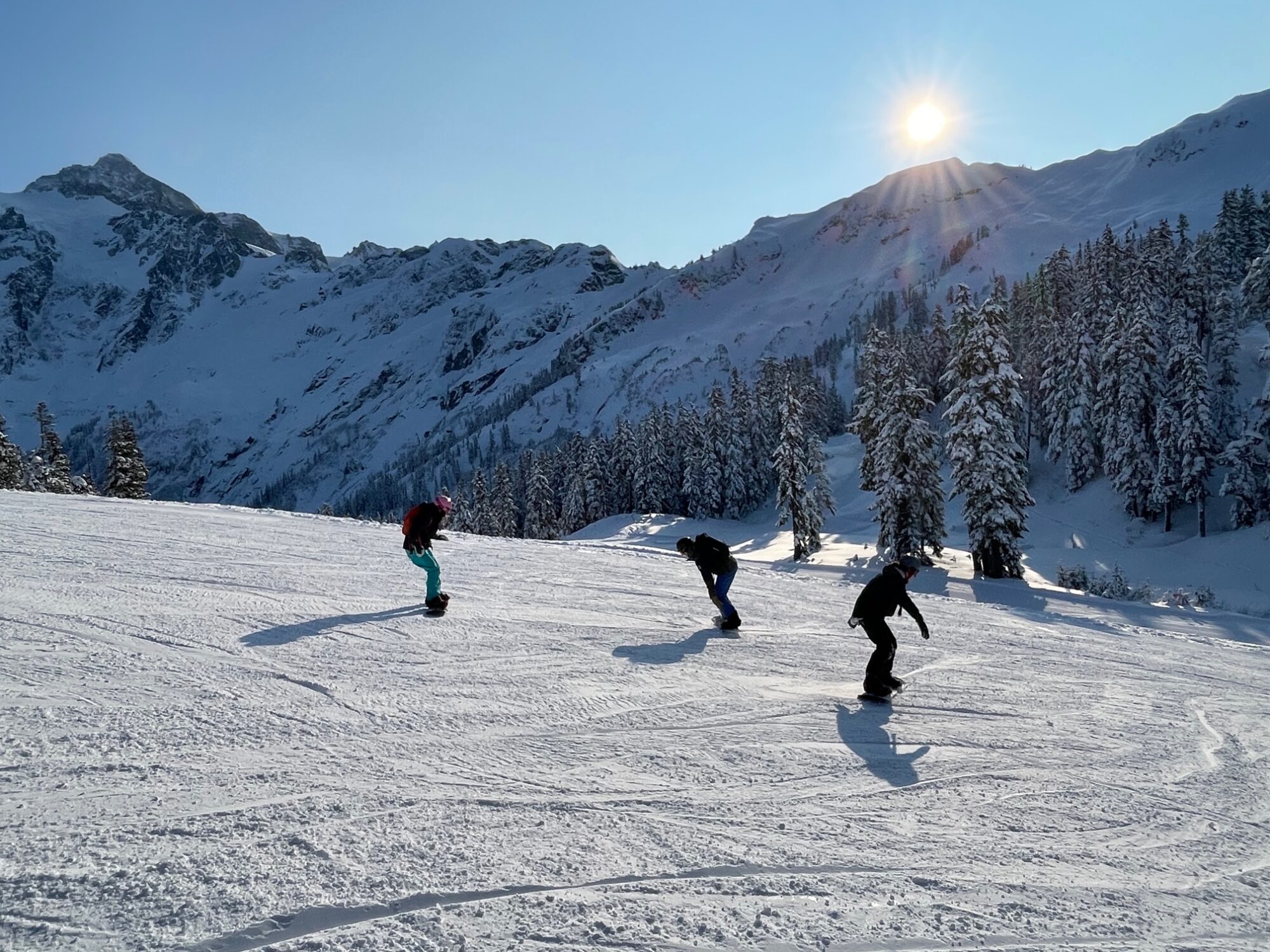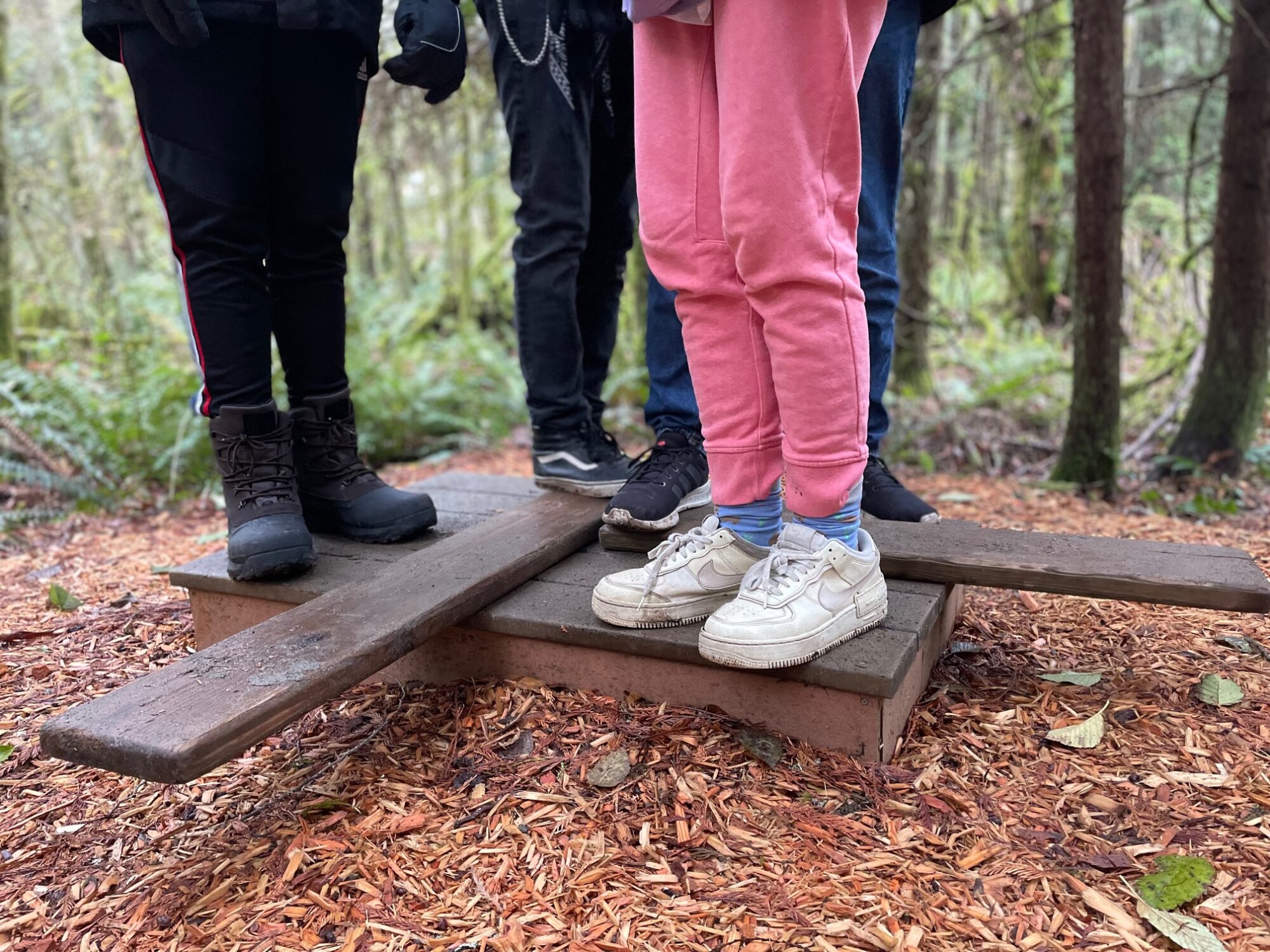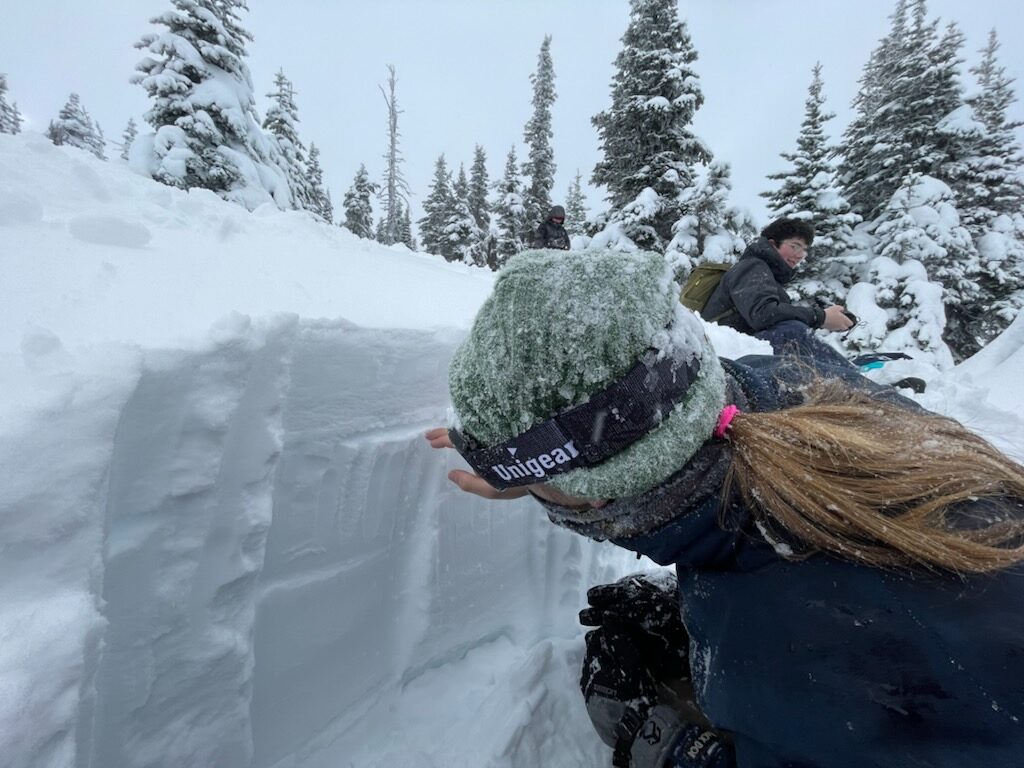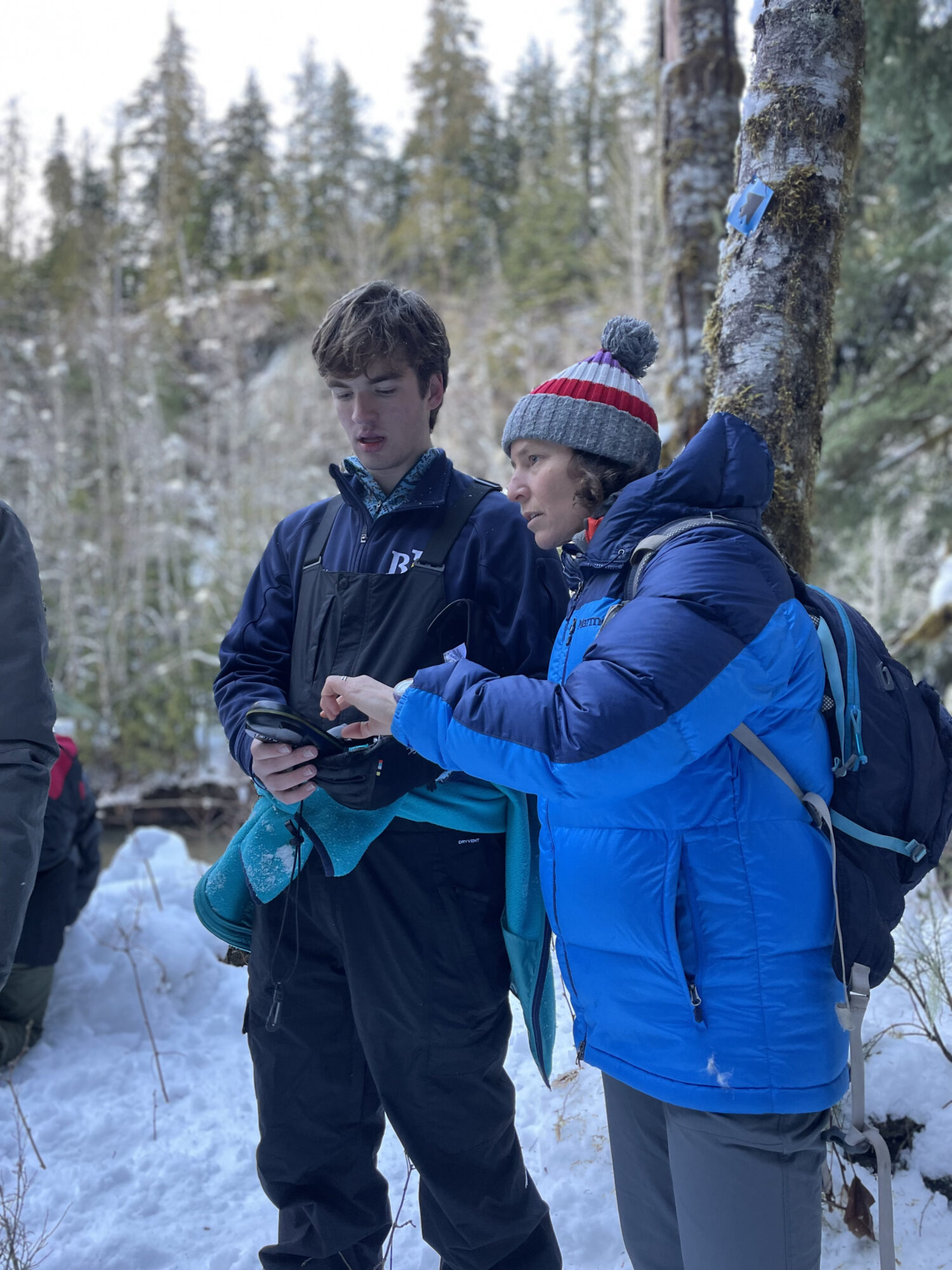Hyla Stories
The Science & Wonder of Winter

Panorama Spotlight
This Panorama course, “Winter: Wellness & Wilderness” was an investigation into the science, communication, group decision-making and logistics essential to safe winter recreation.
Panoramas are multi-week, immersive and interdisciplinary courses that investigate a range of topics through hands-on labs, seminars, creative projects, travel, and critical work. Each Panorama focuses on a central theme and core goal to inspire students to discover something new about themselves and about the world. True expeditionary learning, Panoramas take students into new territory intellectually, geographically and interpersonally.
Dispatches from the Field:

December 8, 2022
The huge snowstorm that hit this week was a great opportunity to practice decision making, flexibility, and safety prioritization required with winter adventures. While road conditions prevented the planned trip to the mountains, this group found adventure closer to home with hiking, ice skating, and team building. We spent a cold day in the woods on the IslandWood campus where Ray Cramer led us through a series of collaborative activities and challenges that build communication, teamwork, and group-decision making – all of which are essential to our focus on the science, tools, skills and mindsets of safe winter adventures. Far beyond maps, clothing and gear, what it takes to be safe in the winter is also pretty useful year-round and throughout life: self-awareness, self-advocacy, and advocacy for others. Long after snow has melted and spring bursts into bloom around us, students will be able to rely on these same skills and habits.
This week’s activities were a great way to get comfortable shifting group dynamics based on the activity or lesson at hand. Different parts of this Panorama allow different personalities to step forward and step back, allowing roles to shift as need to ensure the safety of the group. “This class welcomes students of all levels,” said teacher Erik, “and this week I was really impressed with how naturally students stepped into roles based on their experience level with ice skating, respectfully teaching and learning from each other. They’ll be able to rely on each other to do the same when we’re up in the mountains in more extreme conditions.”

Dec 13, 2022: Last week a brief and beautiful weather window allowed us to head to Hurricane Ridge for good old fun and hands-on avalanche lessons. The day before we left, students accurately predicted that the roads would open, using forecasting resources and the National Park webcams. After lots of logistical planning and preparation, we reached Hurricane Ridge and students got to unleash their creativity and engineering as they built a variety of snow caves – with only one shared shovel!

Next, we proceeded to a NE aspect to dig a snow pit and look for the weak layers buried beneath – conditions noted on the NWAC website that students also checked before out trip. A simple hands-on experiment readily demonstrated the potential of weak buried layers to initiate an avalanche: we dug a pit, identified the problem layer; and did a column stress test. With only three taps at the bottom of the shovel, an 8” deep section on top of buried surface hoar (a weak type of ice crystal) slid off the entire block. As more snow accumulates in winter, more weight is added to the snowpack and this layer “demands extra caution in backcountry travel,” as the NWAC website warns. This small-scale model vividly demonstrated the physics of a snowy mountain and associated risks to winter adventurers, and also provided context for the avalanche training students did with NWAC yesterday. Along with building, playing and learning, we also got to take in the spectacular views from the top of Hurricane Ridge.

Monday, Dec 12: We loaded up the school suburban and left school promptly as planned, with neatly packed ski gear and 50 pounds of food to sustain the energy needs of our students. We picked up Erica Riley Swanson, a local educator and former colleague of Brenda, and made our way up I-5 and 9-North to 542 E (Mount Baker Highway).
After arriving in Glacier, with no cell service, we linked up with Pat, an NWAC forecaster and educator for some field work at the Salmon Ridge Snow Park, along the headwaters of the Nooksack River. These exercises involved practice using avalanche beacons (devices that both transmit and receive signals from each other) that allow backcountry travelers to locate any individual buried in an avalanche. Working in teams, students took turns burying two beacons (inside the gray pad you see Jamie carrying in the photos) for the other team to locate. Each team was able to locate both buried beacons in under 6 minutes, a testament to our group’s cohesion and practiced collaborative group decision making skills.

From the field, we drove back to Glacier to check into our rental and continue our NWAC programming with an avalanche awareness presentation from Pat. Students were engaged and asked questions that connected our field work from earlier in the day, as well as our experiences and tests on Hurricane Ridge. Following the presentation, we got to work on dinner. Every student pitched in with cooking and cleaning and we enjoyed a meal together with pasta, garlic bread, and salad.

Tuesday, Dec 13: What a week to be in the mountains! Having made the tough but safe decision to cancel a trip into the mountains given extreme weather conditions, we were rewarded with glorious skies and snow when we did make it into the mountains.
We made our way to the Mount Baker Ski Area for a day of downhill skiing and snowboarding, taught by our partner Rhett Stephens with Bainbridge Island Board Corps. Once again, students were supportive of each other and patient with themselves trying to learn difficult new skills.
Our time on Mt. Baker turned out to be the best classroom environment we could have hoped for given the focus of our Panorama. The “bluebird” conditions allowed for both stunning views of Mount Shuksan (and north into Canada) as well visual evidence of natural avalanches from the 21 inches of new snow Baker received from Fri-Sat just before our arrival. Students were quick to recognize these avalanches by looking for “crowns” – an often linear, unperturbed layer of snow from which the avalanche released – and debris fields below. These avalanches slide on the same problematic layer we identified at Hurricane Ridge, that also exists on all NE aspects in the Cascades. The conditions were ideal for allowing students to clearly see the very conditions and physics we had been studying, and they also made for a spectacularly beautiful day on the mountain. After returning to our rental in Glacier, our tuckered-out group still found the energy to play the card game “spoons” and make pizzas for dinner.

Wednesday, Dec. 14:
We packed up our gear and supplies once again and left Glacier, arriving at 8 AM at the ski area just as the alpine glow lit up every peak in sight. On this “choose your challenge” day, some students continued to snowboard, others chose to ski, and another group snowshoed to Artist Point. Thanks to the high pressure aloft, we were treated to another bluebird day, which gave us more opportunities to observe subtleties in the snowpack. On the ascent to Artist Point, a finger ran across the snow surface, brushed effortlessly through “surface hoar” or elongated snow crystals that form on cold clear nights; after the next large snowfall, this will be another problematic layer.
We reconvened for lunch, gathered together around a table basked in sunshine under the ever-present Mount Shuksan, as students shared highlights from their fun-filled mornings. After taking one group shot, we loaded up the car and were homeward bound. Traveling west towards Kingston on the ferry, we watched the last rays of light fade from Mount Baker.
Thursday, Dec 15: In a quick turnaround, students rallied to try yet another winter past-time: x-country skiing at Snoqualmie Pass with Ethan of the Mountaineers. With another early start, we were soon east bound on the ferry and graced with a stunning sunrise over the Cascades and Mount Rainier. After arriving at the Crystal Springs trails (10 miles east of Snoqualmie pass), students got on boots and skis and hit the trails. Ethan gave us a lesson on how to use the weight of your feet to both gain and lose ski traction and then we were off, efficiently and effortlessly sliding over flat ground. We had lunch in a picturesque clearing in the woods, the perfect spot to end our winter wonderland adventures. ##
